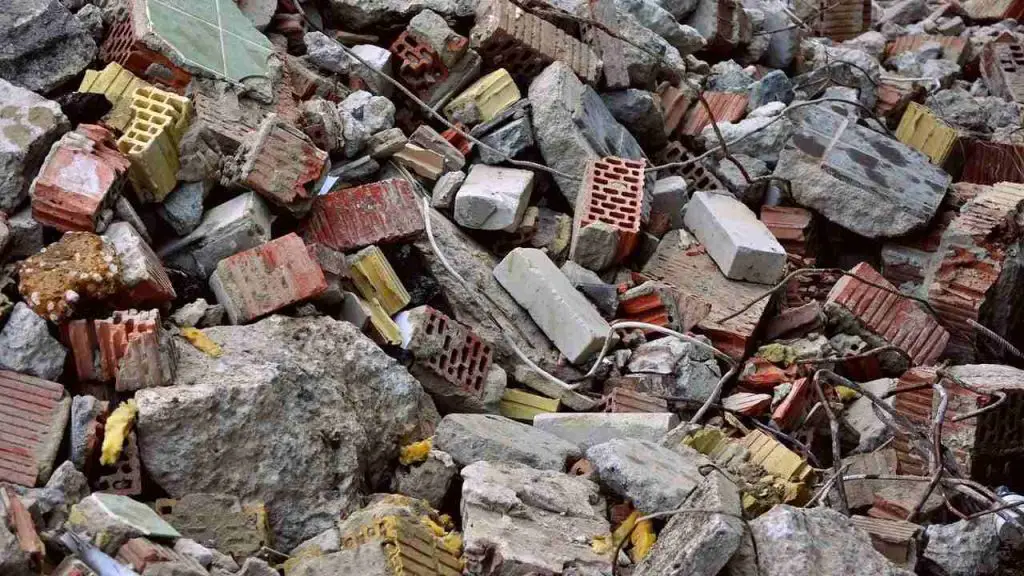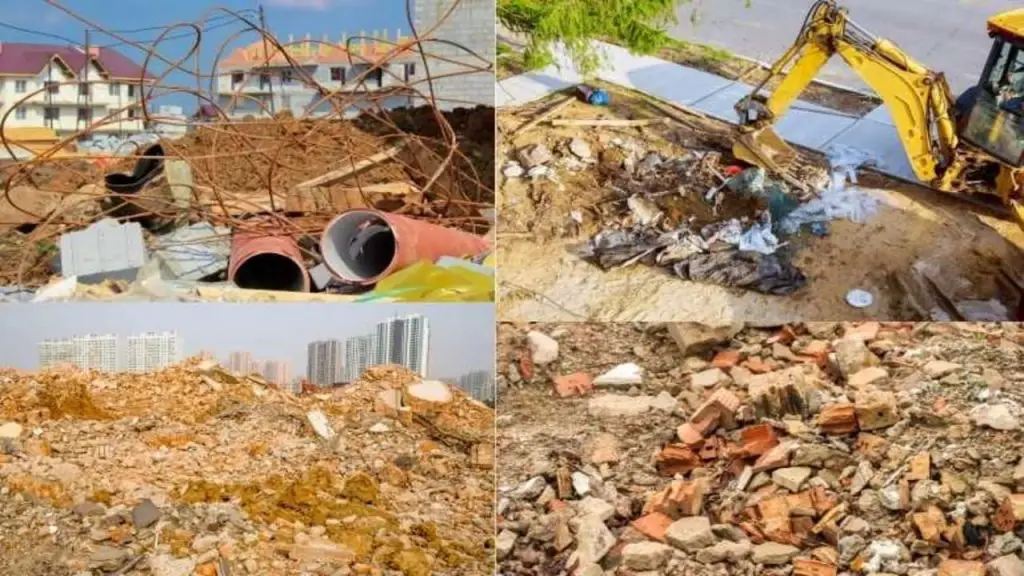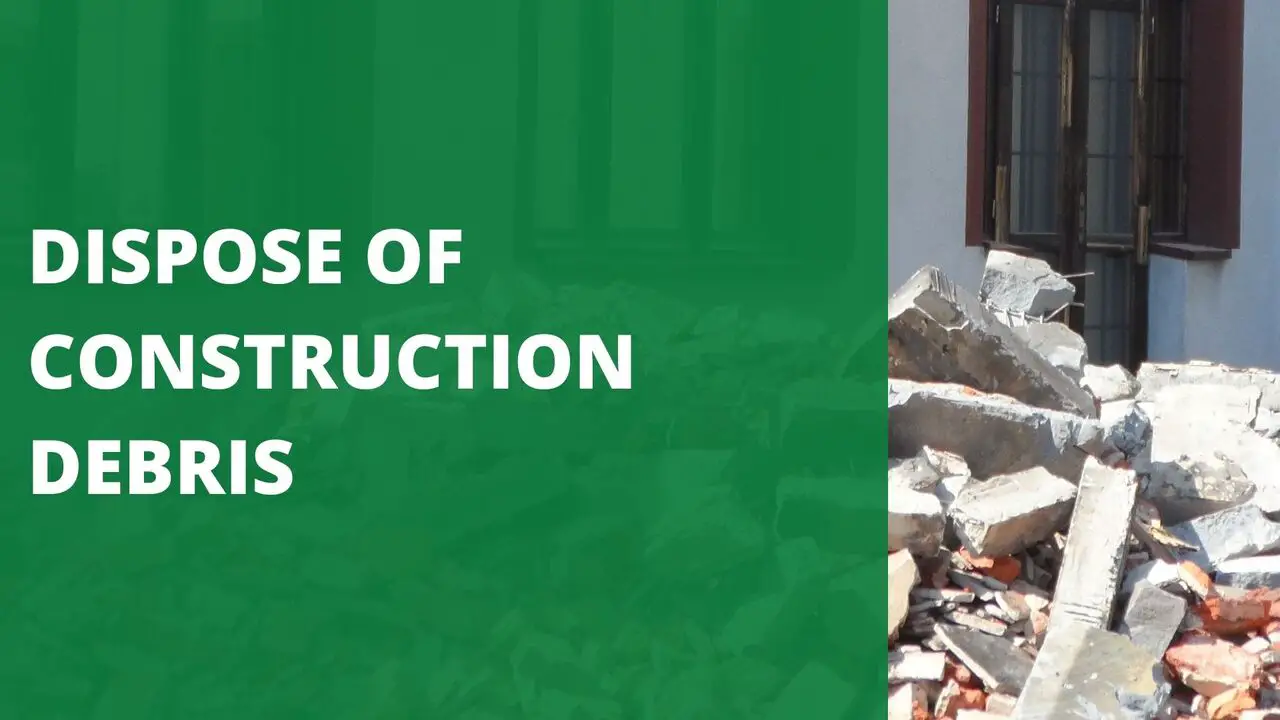In the midst of construction’s awe-inspiring progress and the prospect of new ventures, it frequently leaves in its wake a collection of debris.
This demands careful thought and responsible handling. The management of construction waste is a crucial component of sustainable building practices.
In this guide, we will delve into the details of how to dispose of construction debris, exploring its different types, emphasizing the significance of discerning between clean and dirty debris, and offering a thorough roadmap for an improved waste disposal process.
What Falls Under the Category of Construction Waste?

Construction waste, also known as construction and demolition (C&D) waste, encompasses a diverse array of materials generated during construction, demolition, and renovation activities.
This waste stream includes a variety of items, such as:
1. Concrete, Bricks, and Mortar
- Concrete: The backbone of many construction projects, concrete debris includes broken or discarded pieces of concrete structures or materials.
- Bricks: Leftover or damaged bricks from construction sites contribute to the construction waste stream.
- Mortar: The mixture used to bind bricks or stones in construction, mortar waste is part of the debris generated during demolition or renovation activities.
2. Wood and Lumber
- Wood: Construction projects often involve the use of wood for framing, support structures, and finishing. Waste in this category comprises unused wood, cutoffs, or discarded wooden components.
- Lumber: Similar to wood, lumber waste includes pieces of timber that are no longer needed or are the byproducts of construction activities.
3. Roofing Materials
Construction waste from roofing includes materials such as shingles, tiles, or roofing membranes.
After the completion of a roofing project or during renovations, these materials can become part of the waste stream.
4. Metals and Plastics
- Metals: This category encompasses discarded metal elements from construction sites, including steel beams, reinforcement bars, and other metal components.
- Plastics: Construction projects involve various plastic materials, from packaging to pipes and insulation. The disposal of plastic waste is a significant aspect of managing construction debris.
5. Glass and Ceramics
Construction activities involving windows, glass panels, or ceramic tiles contribute to the generation of glass and ceramic waste.
Proper disposal methods are crucial for these materials due to their potential for recycling.
6. Insulation and Drywall
- Insulation is a material used to regulate temperature in buildings. Waste in this category may include old or unused insulation materials.
- Drywall Also known as gypsum board or plasterboard, drywall is a common construction material. Waste includes damaged or excess drywall.
7. Hazardous Materials
Asbestos Once widely used in construction, asbestos is now recognized as a hazardous material.
Waste containing asbestos must be handled and disposed of with extreme care to prevent health risks.
Lead Paint Construction sites may produce waste containing lead-based paint, posing health hazards.
Proper disposal and, when possible, safe removal are essential.
Now that we know what makes up construction waste, let’s dive into the specific kinds that form this complex puzzle.
Types of Construction Waste
Construction waste can be broadly categorized into two main types: inert and non-inert.
1. Inert Construction Waste
Inert construction waste consists of materials that are essentially stable and do not undergo significant chemical reactions that pose a threat to the environment or human health.
These materials are like the steadfast elements of construction, not prone to harmful transformations.
Examples of inert construction waste include concrete, which remains solid and unchanged over time, as well as bricks and asphalt.
When these materials are disposed of, they don’t introduce harmful substances into the surroundings, making them relatively benign in terms of environmental impact.
2. Non-inert Construction Waste
On the other hand, non-inert construction waste is a bit more dynamic.
These materials have the potential to react with the environment or leach hazardous substances, raising concerns for both ecological systems and human well-being.
For instance, treated wood contains chemicals meant to preserve it but can be harmful if not handled and disposed of properly.
Asbestos, once a popular construction material, poses severe health risks if its fibres become airborne.
Similarly, lead paint can leach toxic lead into the soil, presenting a hazard to both the environment and anyone exposed to it.
Managing non-inert construction waste requires special attention and often involves specific disposal methods to mitigate environmental and health risks.
Understanding the distinction between inert and non-inert construction waste is crucial for effective waste management. It guides how different materials should be handled, disposed of, or even recycled.
By categorizing construction waste in this way, professionals can tailor their approach to ensure not only the efficient removal of debris but also the protection of the environment and the health of those involved in the waste management process.
Clean vs. Dirty Construction Debris
1. Clean Construction Debris
Clean construction debris is the pristine superhero of waste. It’s free from any contamination by hazardous materials like asbestos or lead paint.
Essentially, this type of waste is composed of materials that are environmentally friendly and don’t pose a threat to human health.
Think of it as the recyclable and reusable side of construction waste.
Since it does not carry any harmful baggage, clean construction debris can often be repurposed or recycled without much fuss.
2. Dirty Construction Debris
On the flip side, we have the less glamorous counterpart – dirty construction debris.
This waste stream is not so friendly. It carries hazardous materials that can be harmful to both people and the environment.
Dealing with dirty construction debris requires special attention and handling. Hazardous materials like asbestos or lead paint need careful disposal to ensure they don’t pose risks during or after removal.
It’s the kind of debris that needs a bit more TLC to make sure it doesn’t cause any trouble once it’s out of the construction site.
Now that we understand the distinctions between clean and dirty debris, let’s delve into a step-by-step guide to improving how you dispose of your construction waste.
Ways to Enhance Your Construction Waste Disposal Process

1. Develop a Waste Management Plan
Creating a solid waste management plan is crucial for handling construction waste in a responsible and effective manner.
This plan serves as a guide, detailing procedures for waste identification, segregation, handling, storage, and disposal.
The first step involves classifying different types of construction waste based on their characteristics and potential hazards.
Clear guidelines for segregating waste at its source help prevent contamination and simplify sorting.
Proper handling and storage practices are then implemented to ensure the safe containment of waste materials.
Finally, the plan identifies suitable disposal options for each type of waste, taking into account factors such as environmental impact, regulations, and cost-effectiveness.
In essence, a well-thought-out waste management plan streamlines the entire process, making construction waste disposal both efficient and environmentally responsible.
2. Segregate Waste at the Source
Segregating waste at the source emerges as a pivotal step in elevating the effectiveness of waste management.
This process carried out at the very point where waste is generated, plays a significant role in minimizing contamination and simplifying subsequent sorting efforts.
By allocating distinct containers for different types of waste, the risk of hazardous materials intermingling with non-hazardous counterparts is significantly diminished.
This not only safeguards the integrity of the waste but also reduces the likelihood of cross-contamination.
The practice of segregating waste at its origin, therefore, serves as a proactive measure, enhancing the overall efficiency and safety of the waste management process
3. Minimize Waste Generation
Cutting down on waste generation is a smart way to manage waste that not only saves resources but also lessens the impact on the environment during construction.
To achieve this, various strategies can be put into action. One such method is using prefabricated materials and components, which require less cutting and result in less on-site waste.
Another approach involves optimizing cutting practices to minimize material wastage and make the most of available resources.
Additionally, recognizing materials that can be reused, like surplus lumber or undamaged fixtures, and considering donating them to charities or community organizations, contributes to the overall reduction of waste.
In essence, minimizing waste generation is a forward-thinking tactic that benefits both the construction process and the environment.
4. Recycle and Reuse Construction Materials
Embrace recycling and reusing construction materials whenever you can to save resources and decrease the demand for new ones.
Recycling involves processing waste materials, like concrete, metal, wood, and gypsum, to create new, valuable products.
Work together with recycling facilities to give these materials a second chance. Reusing, on the other hand, means using waste materials directly in new construction projects.
This might include incorporating salvaged bricks, reclaimed lumber, or used doors into creative designs.
Prioritizing recycling and reusing helps conserve resources and lessens the environmental impact linked to producing new construction materials.
5. Choose a Reputable Waste Disposal Contractor
It’s crucial to team up with a licensed and seasoned waste disposal contractor to ensure that construction waste is managed safely, responsibly, and in accordance with regulations.
When choosing a waste disposal contractor, consider a few key factors.
First off, confirm that the contractor has the necessary licenses and permits to deal with the specific types of waste your project generates.
Look into their experience, especially in handling construction waste and hazardous materials.
Make sure their waste disposal methods align with your sustainability objectives and environmental regulations.
Lastly, check references and reviews from previous clients to get a sense of the contractor’s reputation and performance.
Choosing the right waste disposal contractor is a vital step in the overall responsible management of construction waste.
Proper Ways to Dispose of Construction Debris
1. Landfills
Landfills act as controlled dumping grounds for non-hazardous construction debris. These well-managed facilities ensure proper containment and minimize environmental impact.
While landfills play a vital role in waste management, they aren’t the perfect solution for all construction debris.
Occupying valuable land space and potentially emitting harmful substances over time, landfills prompt a preference for recycling or reusing materials whenever feasible.
2. Recycling Facilities
These facilities engage in the processing and remanufacturing of construction materials, creating new products and lessening the need for virgin materials.
Imagine them as enchanting workshops, where discarded construction materials like concrete, metal, wood, and drywall are magically transformed into valuable new products.
These facilities receive these materials, process them into usable components, and, in doing so, not only reduce waste but also conserve resources.
Through the recycling of construction debris, we have the power to diminish our environmental impact and foster a more sustainable future.
3. Hazardous Waste Facilities
Special places called hazardous waste facilities are set up to handle and get rid of dangerous stuff in a safe way.
These places use strict rules and advanced technology to make sure nothing harmful gets into the environment and to keep people healthy.
It’s really important to handle and throw away dangerous waste the right way to keep people and the environment safe.
These facilities are designed to make sure there’s very little chance of anyone being exposed to harmful stuff and to make sure dangerous materials are thrown away in a safe manner.
The way we get rid of waste depends on the type of construction debris and the rules in our area. For things that aren’t dangerous, like regular debris, putting them in landfills might work.
Recycling places are a good choice to help the environment. But when it comes to dangerous waste, it’s a must to handle and dispose of it in special places.
When handling construction debris, it’s smart to work with experienced professionals who know the right way to get rid of it.
They can help you follow the rules and make sure it doesn’t harm the environment too much.
List of Construction Debris Companies
As we wrap up our exploration, let’s check out a list of companies that handle construction debris.
These are experts in using effective and eco-friendly ways to dispose of waste, offering crucial services to projects of any size.
Collaborating with these companies ensures that your construction waste ends up in a sustainable and responsible place.
1. Waste Management: A top waste services provider in North America, Waste Management specializes in collecting, recycling, and disposing of construction and demolition debris.
Their services cover waste hauling, recycling, and landfill disposal.
2. Republic Services: With a strong presence in the United States, Republic Services is a major player in waste management.
They offer diverse solutions for construction waste, including hauling, recycling, and disposal at landfills and transfer stations.
3. Stericycle: Specializing in hazardous waste management, Stericycle handles waste generated from construction projects.
Their services encompass waste collection, transportation, treatment, and disposal.
4. Clean Harbors: A leading hazardous waste management company, Clean Harbors focuses on environmental services.
They provide comprehensive construction waste disposal solutions, including waste characterization, packaging, transportation, treatment, and disposal.
5. Veolia Environmental Services: A global environmental solutions company, Veolia Environmental Services specializes in waste management, including construction waste.
Their services include waste collection, recycling, treatment, and energy-from-waste solutions.
Keep in mind, that proper disposal of construction debris is vital to protect the environment and comply with regulations.
When you use effective waste management methods and team up with trustworthy waste disposal companies, you make sure that construction debris is handled in a safe and sustainable way.
Conclusion
To sum it up, getting rid of construction debris isn’t just a job; it’s a chance to play a part in building a sustainable future.
When the construction industry embraces responsible practices, separates different types of waste, and considers recycling options, it turns debris management into a positive contribution to the environment.
We hope this guide has been valuable to you, and we appreciate you taking the time to read our article.
FAQ’s:
What is the cheapest way to get rid of construction debris?
The most cost-effective way to dispose of construction debris typically involves a combination of strategies.
One common approach is to segregate materials at the construction site, separating recyclables from non-recyclables.
This allows for recycling or reusing certain materials, reducing disposal costs.
Additionally, you can explore local waste disposal facilities or landfills that offer competitive rates.
Some areas also have bulk waste collection services that might be more budget-friendly for larger quantities of debris.
How do you clean after construction?
As for cleaning up after construction, it’s a multi-step process. Begin by removing larger debris and then sweep or vacuum the area to get rid of smaller particles.
Wipe down surfaces, including walls and windows, and consider pressure washing for exterior spaces.
Properly dispose of any remaining construction waste following local guidelines.
A thorough post-construction cleanup ensures a safe and tidy environment once the building or renovation work is complete.

